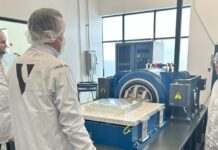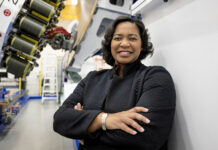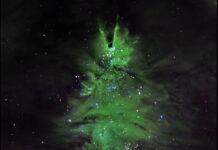From Childhood Dreams to NASA Achievement: The Journey of Julia Khodabandeh
In the 1980s, while most teenagers adorned their walls with posters of their favorite bands, Julia Khodabandeh’s room was a shrine to rockets and fighter jets. This early fascination with aerospace and aeronautics was not just a passing phase; it was a precursor to a distinguished career at NASA.
Julia’s parents were ardent supporters of the Apollo Program, and they played a pivotal role in nurturing her interest in space. Her father, in particular, encouraged her to confront math and science problems head-on. He often told her, “You can take any problem and break it into smaller pieces.” This approach to problem-solving became a cornerstone of her methodical thinking and has remained with her throughout her career.
“When I was growing up, my dad would create practice tests for me the night before my exams,” Julia reminisced. “This preparation made me feel more confident. My growing self-assurance in math and science, coupled with my passion for aerospace, paved the way for my career at NASA.”
Julia Khodabandeh has spent over two decades at NASA, dedicating a significant portion of her career to solid rocket boosters. Over the last decade, she has been instrumental in developing the twin solid rocket boosters for NASA’s Space Launch System (SLS). These boosters are the largest and most powerful solid propellant boosters ever flown, each standing 177 feet tall and capable of generating a maximum thrust of 3.6 million pounds. Together, these twin boosters provide over 75% of the total thrust required to launch the SLS for NASA’s Artemis missions to the Moon.
Julia holds a bachelor’s degree in mechanical engineering and a master’s degree in computational fluid dynamics from the University of Alabama in Huntsville. Early in her career, she worked on Space Station microgravity material processing furnaces and played a vital role in the Space Shuttle Return-to-Flight Program. Her journey continued with her involvement in the Ares rocket solid rocket booster team as part of the Constellation Program, which eventually led her to her current role in the SLS program.
As the motor and pyrotechnic team lead for the SLS Booster Element Office, Julia oversees the design, development, certification, production, and operation of the solid rocket motors, booster separation motors, and pyrotechnics for the SLS twin boosters. Her daily responsibilities include managing schedules and resolving technical issues with her team.
“The flight hardware and test hardware are significant achievements for the team,” Julia noted. “Behind these accomplishments are countless hours, weeks, and months of collaborative effort to tackle issues and deliver results. It’s the people that make us successful, and teamwork is my favorite part of what we do. Someone once said, ‘You have to build a successful team before you can build successful hardware.’ I couldn’t agree more!”
Outside of her professional life, Julia is committed to giving back to her community. She volunteers at a local rescue mission, providing support to women struggling with substance abuse. Additionally, she mentors students in the Huntsville area, hoping to instill in them the same confidence her father gave her and inspire the next generation of NASA scientists and engineers.
As someone who grew up with posters of rockets on her walls, Julia is thrilled to be part of the team responsible for sending astronauts around the Moon on Artemis II. “The incredible success of Artemis I is something that I will never forget,” she said. “We have demonstrated what we’re capable of, and I can’t wait to see what we accomplish going forward on the Artemis Program.”
NASA’s Artemis program aims to land the first woman, the first person of color, and its first international partner astronaut on the Moon. The Space Launch System (SLS) is a critical component of NASA’s deep space exploration strategy, working in conjunction with the Orion spacecraft, advanced spacesuits, rovers, the Gateway lunar orbiting outpost, and commercial human landing systems. SLS is the only rocket capable of sending Orion, astronauts, and supplies to the Moon in a single launch.
The Artemis program represents a new era of lunar exploration, with goals that extend beyond just landing on the Moon. NASA plans to establish a sustainable human presence on the Moon by the end of this decade, which will serve as a stepping stone for future missions to Mars. This ambitious plan includes building lunar habitats, deploying advanced robotics, and conducting scientific research that will expand our understanding of the Moon and its potential resources.
For those interested in the technical aspects, the SLS rocket is designed with a modular architecture, allowing it to evolve over time. The initial configuration, known as Block 1, will be capable of sending more than 26 metric tons to the Moon. Future configurations, such as Block 1B and Block 2, will have even greater lift capabilities, enabling more complex missions and larger payloads.
The Orion spacecraft, which will be launched atop the SLS, is designed to carry astronauts on deep space missions. It includes a crew module for living and working in space, a service module for propulsion and power, and a launch abort system for crew safety. Together, SLS and Orion form the backbone of NASA’s deep space exploration capabilities.
The Gateway, another crucial element of the Artemis program, will be a space station orbiting the Moon. It will serve as a staging point for lunar landings, a research laboratory, and a hub for international and commercial partnerships. The Gateway will enable longer stays on the lunar surface and provide a platform for testing new technologies that will be essential for future Mars missions.
In addition to these technological advancements, NASA is also focused on fostering international collaboration and commercial partnerships. The Artemis program includes contributions from space agencies around the world, as well as private companies developing lunar landers and other mission-critical technologies. This collaborative approach aims to create a sustainable and inclusive lunar exploration ecosystem.
Julia Khodabandeh’s journey from a young girl with a passion for rockets to a key player in NASA’s Artemis program is a testament to the power of perseverance, teamwork, and the pursuit of one’s dreams. Her story is an inspiration to aspiring scientists and engineers everywhere, showing that with dedication and support, the sky is not the limit, but just the beginning.
For more information on the Artemis program and other inspiring stories, you can visit NASA’s official website and explore the “I am Artemis” features. These stories highlight the diverse and talented individuals who are contributing to humanity’s next giant leap in space exploration.
For more Information, Refer to this article.


































